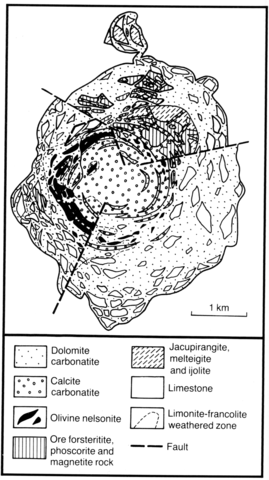stripes
The Essei complex is located 30 km north of Essei lake and is the most southerly occurrence of the Maimecha-Kotui Province. The complex and an apatite deposit associated with it have been investigated by Porshnev and Suvalova (1970), Egorov (1991) and Kravchenko and Bagdasarov (1987). According to geophysical and exploration data the complex has an oval form and dimensions of 3.5x4.2 km. The country rocks are mainly limestones, including dolomites, which are cut by dolerite dykes. The complex has a symmetrical, concentrically zoned structure and is composed principally of carbonatite and rocks of the phoscorite series with jacupirangite, melteigite and ijolite occupying less than 0.7 km2. Relicts of olivinite have been encountered in jacupirangite and melteigite. The jacupirangite and melteigite, which appear to form a discontinuous, steeply dipping body, are cut by veins of phoscorite and carbonatite and are also known from xenoliths in the younger rocks. The main minerals of the jacupirangite and melteigite are clinopyroxene (up to 90%), nepheline, biotite, titanomagnetite, titanite and perovskite with minor olivine, aegirine-augite, apatite, melanite, K-feldspar, phlogopite, zeolites and cancrinite. The ijolites are composed of 50-60% nepheline, 40-50% pyroxene with titanomagnetite, biotite-phlogopite, melanite and accessory perovskite, titanite, apatite, cancrinite, zeolite and calcite. The rocks of the phoscorite series form two discontinuous belts in the northern central area of the complex. The more northerly belt comprises magnetite phoscorite rich in forsterite whereas the more southerly belt contains nelsonites. The principal minerals of the phoscorites are calcite, apatite, magnetite, forsterite and biotite with accessory baddeleyite and zircon. Panina and Shatskiy (1974a) studied primary melt and liquid-gas inclusions in apatite and forsterite from these rocks and inclusions in nepheline and pyroxene from silicate rocks (Panina and Shatskiy, 1974b). Dolomite carbonatite forms a central circular stock and a series of arcuate dykes and veins. It is composed of dolomite, apatite, magnetite and minor forsterite, aegirine-diopside, pyrrhotite and pyrochlore. In the very centre of this body the carbonatite is almost free of none-carbonate minerals. The dolomite stock is surrounded by a 0.5-1.5 km wide calcite carbonatite, in which calcite is the sole carbonate mineral; olivine, magnetite, apatite and phlogopite are also present in these carbonatites.
BOGADITSA, V.P., BRAGINA, V.I., GERDT, A.A., DANILIN, K.L., EGOROV, L.S., KAZITSKY, M.L., KOROLEV, E.M., MALISHEV, A.A., MATUKHINA, V.G., MKRTCHYAN, A.K., RUSAKOV, D.K., SERGEEV, V.L., SHALMINA, G.G. and SHERMAN, M.L. 1983. Y.N. Zanin (ed) The apatite deposits of the Maimecha-Kotui province and their geological and economic assessment. Siberian Branch of the Academy of Sciences, Novosibirsk. 83 pp.
DANILIN, E.L., ZANIN, Y.N., VAHRAMEEV, A.M., GILINSKAYA, L.G., KRIVOPUTSKAYA, L.M. STOLKOVSKAYA, V.N. and ZAMIRAILOVA, A.G. 1982. Phosphate-bearing weathering ores and phosphorites of the Maimecha-Kotui province of ultrabasic-alkaline rocks. Nauka, Moscow. 73 pp.
EGOROV, L.S. 1969. The melilite rocks of the Maimecha-Kotui province. Nedra, Leningrad. 247 pp.
EGOROV, L.S. 1980. The rocks of the phoscorite series (apatite-magnetite ores) of the Essei massif and some general problems of petrology, classification and nomenclature of apatite-olivine-magnetite rocks of ijolite-carbonatite complexes. In L.S. Egorov (ed) Alkaline magmatism and apatite-bearing rocks of the north of Siberia. 39-60. Trudy Nauchno-Issledovatel'skogo Instituta Geologii Arktiki, Leningrad.
EGOROV, L.S. 1991. Ijolite carbonatite plutonism (case history of the Maimecha-Kotui complexes northern Siberia). Nedra, Leningrad. 260 pp.
KRAVCHENKO, S.M. and BAGDASAROV, Yu.A. 1987. Geochemistry, mineralogy and origin of the apatite-bearing massifs (Meimecha-Kotui carbonatite province. Nauka, Moscow. 128 pp.
*PANINA, L.I. and SHATSKIY, V.S. 1974a. Inclusions of melt in magnetite-apatite rock of the Yessey carbonatite intrusion. Doklady Earth Science Sections, American Geological Institute, 209: 149-51.
*PANINA, L.I. and SHATSKIY, V.S. 1974b. Traprock and ultramafic alkalic rocks of the Yessey carbonatite intrusion. Doklady Earth Science Sections, American Geological Institute, 209: 144-7.
PORSHNEV, G.J. and SHUVALOVA, V.Z. 1970. The Essei alkaline-ultrabasic massif and a deposit of magnetite-apatite ores associated with it. Geology and mineral deposits of the western part of the Siberian platform. Transactions of the Krasnoyarsk Geological Office, 238-44.

